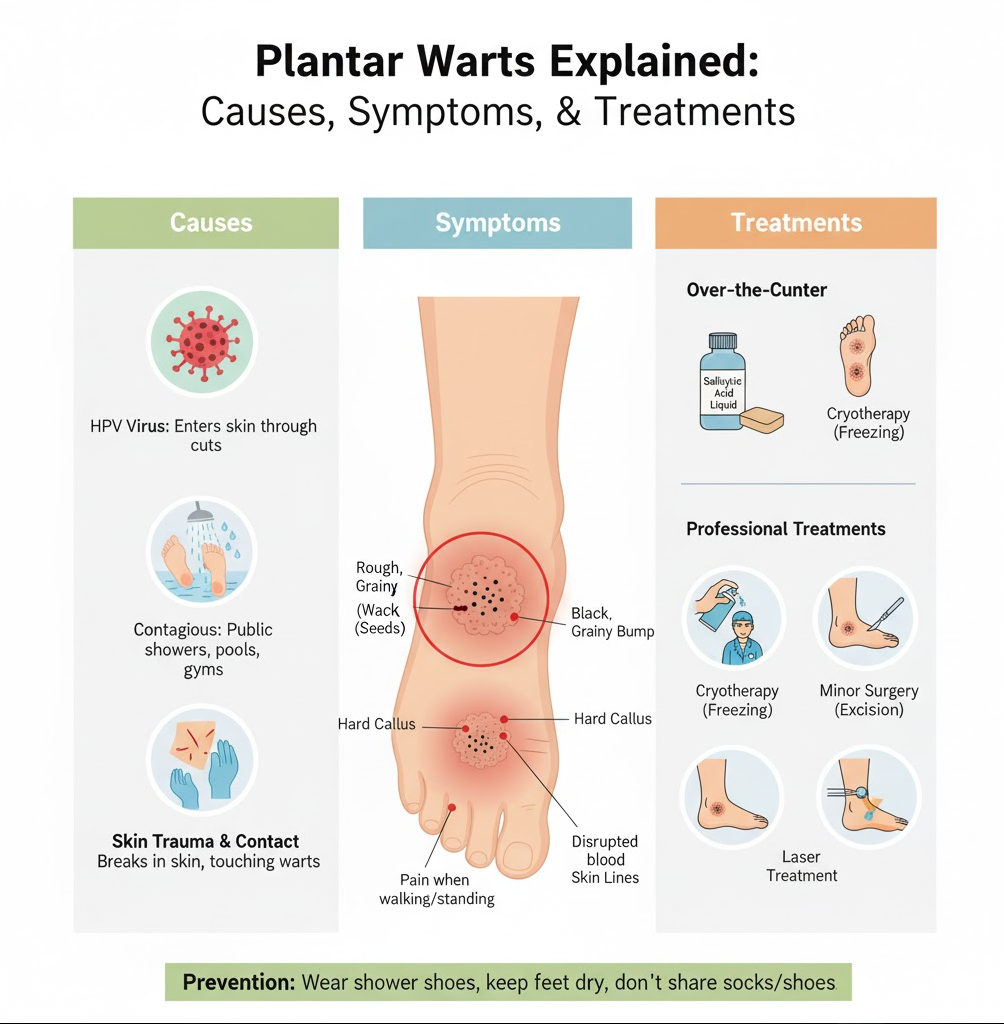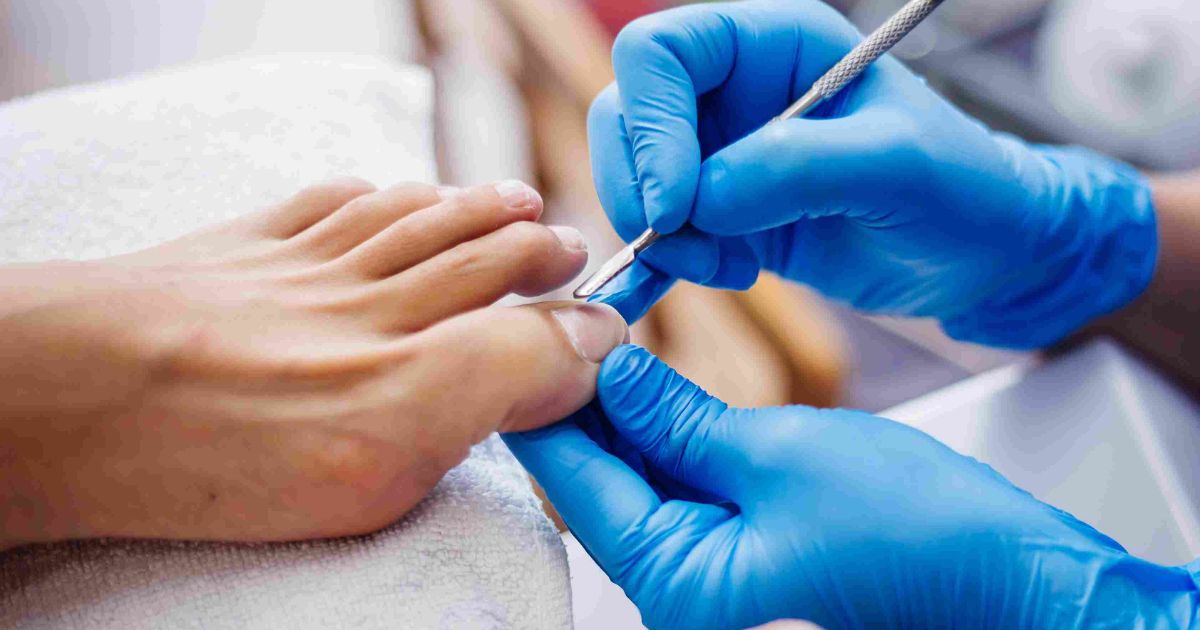Have you ever felt a small, rough bump on the bottom of your foot that makes walking feel like a pebble stuck in your shoe? If that sounds familiar, you’ve likely come across a plantar wart. While the name might sound a bit strange, it’s simply a common type of wart that appears on the soles of your feet, caused by the human papillomavirus (HPV).
These stubborn little bumps can be a real pain, literally. They often make standing, walking, or running uncomfortable and might even make you feel self conscious about going barefoot. If you’re wondering what they are, why you have one, and how to eliminate plantar warts, you’ve come to the right place. This guide will walk you through everything, from identifying plantar warts to exploring the best treatments. We’ll break down the causes, symptoms, and prevention tips so you can finally get back on your feet, feeling comfortable and confident.
What Causes Plantar Warts?
So, where do these little bumps come from? It’s not from frogs, that’s for sure! The real culprit is a tiny germ called the human papillomavirus, or HPV for short. Think of it as a sneaky little virus that loves to hang out in warm, damp places.
The Role of HPV in Plantar Wart Formation
HPV is always on the lookout for a way into your skin. It usually finds its way in through tiny, invisible cuts or scrapes on the bottoms of your feet. Once inside, it sets up camp and tells your skin to grow extra cells, which creates the rough, bumpy wart you see and feel. It’s the virus’s way of building itself a tiny home.
How Do Plantar Warts Spread?
These warts are contagious, meaning they can spread from person to person. You can pick up the HPV virus by walking barefoot in public places where the germ thrives, like swimming pool decks, locker rooms, and communal showers. You can also get them by sharing towels, socks, or shoes with someone who has one. It’s a critical reason for keeping your feet clean and protected.
Why Are Children and Athletes More Prone?
Have you ever wondered why kids and people who play many sports seem to get plantar warts more often? Both groups tend to have more cuts and scrapes on their feet and often spend more time barefoot in shared spaces like gyms and pools. Plus, kids’ immune systems are still learning to fight off new germs, making them an easier target for the pesky HPV virus.
How to Identify Plantar Warts
You think you might have a plantar wart, but you’re not quite sure. Let’s play detective and figure out what to look for. These little foot invaders have a few telltale signs to help you spot them.
Symptoms of Plantar Warts: What to Look For
First, check for a small, rough growth on the bottom of your foot. It might look a bit like a tiny cauliflower. You may also notice little black dots in the center. People sometimes call these wart seeds, but they’re small, clotted blood vessels. Don’t be alarmed; it’s totally normal.
Another big clue is discomfort. If you feel a sharp pain when you squeeze the sides of the bump, it’s a strong hint you’re dealing with a plantar wart. Walking on it can also feel like a small stone is stuck in your shoe.
Plantar Warts vs. Corns: How to Tell the Difference
Mixing up plantar warts and corns is easy because they can look similar. Here’s a simple trick: corns are usually hard, thick patches of skin that form from rubbing or pressure, and they don’t have those little black dots. Conversely, warts will interrupt the natural lines and ridges of your skin, while corns don’t. Plus, corns are typically painful when you press directly on them, whereas warts hurt more when you pinch them from the sides.
When to Seek Professional Diagnosis
While you can often identify a plantar wart at home, seeing a doctor or a foot specialist (a podiatrist) is always a brilliant idea if you’re uncertain. You should make an appointment if the wart is very painful, starts to bleed, changes color, or spreads. A professional can give you a precise diagnosis and help you figure out how to say goodbye to that pesky bump for good.
Treatment Options for Plantar Warts
It’s time to talk about how to send that pesky wart packing. The good news is you have many options, from things you can do at home to treatments from a doctor. Let’s explore how to eliminate plantar warts and make your feet feel happy again.
Over the Counter Solutions
Your local pharmacy has some helpful tools. You can find treatments with salicylic acid in a gel, liquid, or patch. This medicine works by gently peeling away the layers of the wart over a few weeks. There are also freeze off kits that work similarly to a doctor’s treatment but are less powerful.
Medical Treatments
If at home methods aren’t cutting it, a doctor can help with stronger treatments.
- Cryotherapy: This is where a doctor freezes the wart with super cold liquid nitrogen. It’s quick but can sting a little.
- Laser Therapy: A special light zaps the blood vessels inside the wart, causing it to fall off over time.
- Minor Surgery: Sometimes, a doctor might numb your foot and remove the wart.
Home Remedies That Work (and Those That Don’t)
You might have heard about using duct tape. While some people say it works, there isn’t much proof. It involves covering the wart with tape, which might help peel away layers. It’s best to stick with treatments that are known to be effective and discuss any home remedy ideas with a doctor first to stay safe.
Prevention Tips for Wart Free Feet
Now that you know how to eliminate plantar warts, let’s talk about the best trick: not getting them in the first place! A few simple habits can go a long way in keeping your feet happy, healthy, and completely wart free. Think of it as building a super strong shield for your feet.
Best Practices for Foot Hygiene
Keeping your feet clean is your first line of defense. Wash your feet with soap and water every day, and don’t forget to scrub between your toes! After washing, dry your feet thoroughly. That sneaky HPV virus loves moisture, so a dry foot is one of its least favorite places. Changing your socks daily is also great, especially if your feet get sweaty.
Protecting Your Feet in Public Spaces
Remember how we said the HPV virus hangs out in warm, damp places? Public pools, gym locker rooms, and shared showers are like a five star resort for germs. Always wear flip flops, shower shoes, or sandals in these areas to keep them off your feet. Creating a barrier between your skin and the floor is one of the easiest ways to prevent plantar warts. It’s a small step that makes a huge difference.
Boosting Your Immune System to Fight HPV
Your body has its own amazing defense system called the immune system. A strong immune system is better at fighting germs, including the HPV virus. You can help power it up by eating lots of fruits and vegetables, getting plenty of sleep, and drinking enough water. When your body is strong and healthy, it’s much harder for viruses to move in and cause trouble.
How to Disinfect Shoes and Personal Items
If you or someone in your family has had a wart, it’s smart to clean things that might have come into contact with it. To prevent the virus from spreading, avoid sharing towels, socks, or shoes. You can also use disinfecting sprays or wipes to clean the inside of shoes. This helps ensure that any lingering germs are shown the door so they don’t get a chance to cause another infection.

What Are the Risks of Ignoring Plantar Warts?
You might wonder, What happens if I leave it alone? While some plantar warts can go away independently, ignoring them isn’t always the best idea. Sometimes, what starts as a tiny, harmless bump can lead to bigger problems if you don’t keep an eye on it.
Potential Complications: Pain, Infection, and Spreading
One of the main risks is pain. A single wart can grow larger or deeper into your foot, making every step uncomfortable. Sometimes, new warts can pop up nearby, forming a mosaic wart cluster. This can make walking or running even more painful.
Another risk is infection. You can create a small open wound if you pick at or scratch a wart. This gives other germs a chance to get in, which could lead to a more serious skin infection. If you’re not careful, the wart virus can also spread to different parts of your foot or even to other people in your home.
Can Plantar Warts Affect Your Posture or Mobility?
Believe it or not, an untreated wart can change how you walk. To avoid putting pressure on the sore spot, you might start to stand or walk differently without realizing it. Over time, this change in your posture can cause aches and pains in your feet, ankles, knees, or even your back. Taking care of plantar warts early helps keep your whole body aligned and happy.
For more information, visit us:
Conclusion
And there you have it! You’re now officially a plantar wart expert. We’ve covered everything from what causes these pesky bumps to how you can send them packing and keep them from returning. Dealing with foot troubles is never fun, but knowing what you’re up against is the first step toward getting things sorted out.
Taking the First Step Toward Healthy, Wart Free Feet
Remember, the best plan is to protect your feet. Simple things like wearing sandals in public showers and keeping your feet clean and dry can make a huge difference. By following these tips, you’re building a strong defense to keep your feet healthy and happy.
If you already have a wart, don’t panic. You have plenty of options, from at home treatments to help from a doctor. The most important thing is to take action. Don’t let a slight bump turn into a significant pain. If a wart is bothering you, changing, or won’t go away, it’s always a great idea to chat with a foot specialist. They can offer expert advice and ensure you get the best foot care.
FAQs
Are Plantar Warts Contagious?
Yes, they are. The HPV virus that causes them can spread through direct contact or by walking barefoot in shared, damp areas like locker rooms. That’s why wearing sandals in public showers and avoiding sharing socks or towels is a good idea.
Can You Prevent Plantar Warts from Coming Back?
While you can’t guarantee a wart will never return, you can lower the chances. The best way is to follow the prevention tips we talked about earlier. Keeping your feet clean and dry, wearing shoes in public areas, and taking care of your immune system are your best defenses against future warts.
What’s the Best Time to See a Doctor?
You should visit a doctor if your wart is causing you a lot of pain, starts to bleed, changes its appearance, or doesn’t go away with at home treatments. A doctor can determine if it’s just a wart and offer stronger treatments to help get rid of it for good.
Welcome to Heel Tooth! I’m Lee Marvin.
